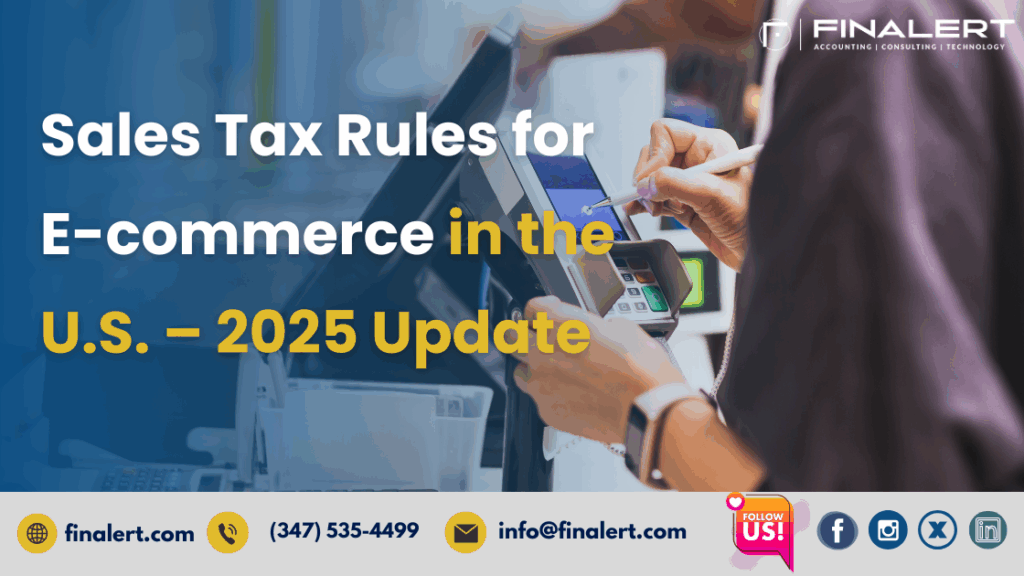
Regulation around sales tax for e-commerce businesses has continued to evolve rapidly, and 2025 is no exception. With more states tightening enforcement, expanding economic nexus thresholds, and increasing scrutiny of online transactions, U.S. e-commerce businesses face a complex and shifting tax landscape.
Understanding and complying with the latest sales tax rules is not just about following the law, it’s about protecting your business from unexpected liabilities, audits, and penalties. Whether you sell on Shopify, Amazon, Etsy, or your platform, staying current with 2025 sales tax changes is essential for financial health and operational continuity.
This article outlines the most important updates, rules, and best practices U.S.-based e-commerce businesses need to know for 2025.
Sales tax nexus determines whether a business must collect sales tax in a particular state. In 2025, there are two primary forms of nexus:
As of 2025, all 45 states with a sales tax impose economic nexus laws, many modeled after the 2018 South Dakota v. Wayfair decision.
In 2025, a growing number of states will have lowered their thresholds to capture more small and mid-sized sellers. Common thresholds now include:
However, some states are eliminating the transaction-count threshold, focusing exclusively on sales volume. Others have introduced tiered thresholds for digital vs. tangible goods.
More states now explicitly tax digital products—like e-books, music downloads, and streaming subscriptions—as well as Software-as-a-Service (SaaS) platforms. If your e-commerce business offers any of these, you may now need to collect sales tax in additional states.
If you sell through third-party platforms like Amazon, Etsy, or Walmart Marketplace, you may not be responsible for collecting and remitting sales tax yourself. Most states have marketplace facilitator laws, which shift the burden of collection to the platform.
Even if the marketplace handles sales tax collection:
Failing to comply with these obligations—even if you think the platform “handles it all”—can lead to compliance issues.
States may require sales tax returns to be filed monthly, quarterly, or annually based on your total volume. In some cases, once a nexus is established—even if your sales fall later—you may still be expected to file returns for years.
Sales tax in the U.S. isn’t just a state-level issue. Many states allow local jurisdictions (cities, counties) to add additional sales tax rates, creating hundreds of variations.
Your sales tax collection must:

States are expanding the types of goods and services subject to sales tax, especially in:
Always verify taxability per state, as what’s taxable in one state may be exempt in another.
If you sell a combination of taxable and non-taxable items (e.g., physical products with digital content), these are often treated as “bundled transactions,” which many states consider fully taxable. In 2025, states are tightening the rules around how these should be reported.
Manually tracking sales tax rates across states and jurisdictions is no longer feasible for most e-commerce sellers. Instead, businesses should invest in sales tax automation solutions that integrate with:
These tools:
If you haven’t implemented automation yet, 2025 is the year to do it. Enforcement is increasing, and audits are expanding beyond major enterprises to mid-sized online sellers.
Use this checklist to ensure you’re staying ahead of current regulations:
Evaluate Nexus Exposure
Register Where Required
Update Product Taxability
Automate Sales Tax Collection
File and Remit Sales Tax
Keep Records
Ignoring Nexus in New States
Don’t assume small sales don’t matter. If you exceed thresholds—even briefly—you may owe sales tax retroactively.
Relying on Marketplace Only
If you also sell through your site, you’re responsible for collecting and filing tax yourself.
Assuming All Digital Products Are Non-Taxable
That was true years ago. In 2025, most states will tax digital goods and subscriptions.
Filing Incorrectly or Not at All
Many states require returns even if no tax is due. Missing a filing can lead to penalties and non-compliance flags.
Sales tax compliance for e-commerce in 2025 is more demanding than ever, but it doesn’t have to be overwhelming. By understanding how regulations have shifted, staying on top of economic nexus rules, and using the right tools, you can protect your business from unnecessary risk and focus on growth.
With tax authorities expanding enforcement and technology making compliance more achievable, now is the time to take action. Review your nexus exposure, update your systems, and streamline your filing strategy before small issues become major liabilities.
Finalert Consulting & Accounting specializes in helping online businesses simplify sales tax compliance through fractional CFO support, nexus reviews, and tax automation setup. Let us know if you’d like help creating a customized compliance roadmap for your business.
Similar Articles
No results available
Get in touch with Finalert today for tailored business solutions!
No results available
Ready to thrive? Connect with Finalert today and let’s succeed together in the dynamic global market.
© 2025 Finalert. All rights reserved.
Ready to thrive in the dynamic global market? Finalert LLC offers expert financial services, including accounting, consulting, and technology solutions, tailored to your business needs.
Address
Accounting
Quick Links
Consulting
Industries
© 2025 Finalert LLC. All rights reserved.